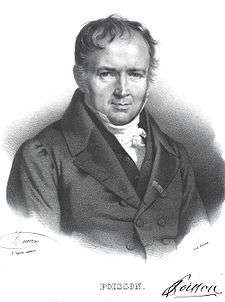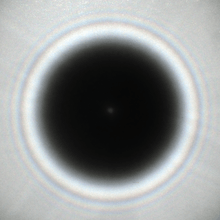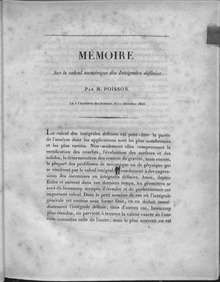Siméon Denis Poisson
Baron Siméon Denis Poisson FRS FRSE (French: [si.me.ɔ̃ də.ni pwa.sɔ̃]; 21 June 1781 – 25 April 1840) was a French mathematician, engineer, and physicist who made many scientific advances.
Siméon Poisson | |
|---|---|
 Siméon Denis Poisson (1781–1840) | |
| Born | 21 June 1781 |
| Died | 25 April 1840 (aged 58) |
| Nationality | French |
| Alma mater | École Polytechnique |
| Known for | Poisson process Poisson equation Poisson kernel Poisson distribution Poisson bracket Poisson algebra Poisson regression Poisson summation formula Poisson's spot Poisson's ratio Poisson zeros Conway–Maxwell–Poisson distribution Euler–Poisson–Darboux equation |
| Scientific career | |
| Fields | Mathematics |
| Institutions | École Polytechnique Bureau des Longitudes Faculté des sciences de Paris École de Saint-Cyr |
| Academic advisors | Joseph-Louis Lagrange Pierre-Simon Laplace |
| Doctoral students | Michel Chasles Joseph Liouville |
| Other notable students | Nicolas Léonard Sadi Carnot Peter Gustav Lejeune Dirichlet |
| Part of a series on |
| Classical mechanics |
|---|
Second law of motion |
|
Core topics |
|
Categories ► Classical mechanics |
Biography
Poisson was born in Pithiviers, Loiret district in France, the son of Siméon Poisson, an officer in the French army.
In 1798, he entered the École Polytechnique in Paris as first in his year, and immediately began to attract the notice of the professors of the school, who left him free to make his own decisions as to what he would study. In 1800, less than two years after his entry, he published two memoirs, one on Étienne Bézout's method of elimination, the other on the number of integrals of a finite difference equation. The latter was examined by Sylvestre-François Lacroix and Adrien-Marie Legendre, who recommended that it should be published in the Recueil des savants étrangers, an unprecedented honor for a youth of eighteen. This success at once procured entry for Poisson into scientific circles. Joseph Louis Lagrange, whose lectures on the theory of functions he attended at the École Polytechnique, recognized his talent early on, and became his friend. Meanwhile, Pierre-Simon Laplace, in whose footsteps Poisson followed, regarded him almost as his son. The rest of his career, till his death in Sceaux near Paris, was nearly occupied by the composition and publication of his many works and in fulfilling the duties of the numerous educational positions to which he was successively appointed.[1]
Immediately after finishing his studies at the École Polytechnique, he was appointed répétiteur (teaching assistant) there, a position which he had occupied as an amateur while still a pupil in the school; for his schoolmates had made a custom of visiting him in his room after an unusually difficult lecture to hear him repeat and explain it. He was made deputy professor (professeur suppléant) in 1802, and, in 1806 full professor succeeding Jean Baptiste Joseph Fourier, whom Napoleon had sent to Grenoble. In 1808 he became astronomer to the Bureau des Longitudes; and when the Faculté des sciences de Paris was instituted in 1809 he was appointed a professor of rational mechanics (professeur de mécanique rationelle). He went on to become a member of the Institute in 1812, examiner at the military school (École Militaire) at Saint-Cyr in 1815, graduation examiner at the École Polytechnique in 1816, councillor of the university in 1820, and geometer to the Bureau des Longitudes succeeding Pierre-Simon Laplace in 1827.[1]
In 1817, he married Nancy de Bardi and with her, he had four children. His father, whose early experiences had led him to hate aristocrats, bred him in the stern creed of the First Republic. Throughout the Revolution, the Empire, and the following restoration, Poisson was not interested in politics, concentrating on mathematics. He was appointed to the dignity of baron in 1821;[1] but he neither took out the diploma nor used the title. In March 1818, he was elected a Fellow of the Royal Society,[2] in 1822 a Foreign Honorary Member of the American Academy of Arts and Sciences,[3] and in 1823 a foreign member of the Royal Swedish Academy of Sciences. The revolution of July 1830 threatened him with the loss of all his honours; but this disgrace to the government of Louis-Philippe was adroitly averted by François Jean Dominique Arago, who, while his "revocation" was being plotted by the council of ministers, procured him an invitation to dine at the Palais-Royal, where he was openly and effusively received by the citizen king, who "remembered" him. After this, of course, his degradation was impossible, and seven years later he was made a peer of France, not for political reasons, but as a representative of French science.[1]
As a teacher of mathematics Poisson is said to have been extraordinarily successful, as might have been expected from his early promise as a répétiteur at the École Polytechnique. As a scientific worker, his productivity has rarely if ever been equaled. Notwithstanding his many official duties, he found time to publish more than three hundred works, several of them extensive treatises, and many of them memoirs dealing with the most abstruse branches of pure mathematics,[1] applied mathematics, mathematical physics, and rational mechanics. (Arago attributed to him the quote, "Life is good for only two things: doing mathematics and teaching it."[4])
A list of Poisson's works, drawn up by himself, is given at the end of Arago's biography. All that is possible is a brief mention of the more important ones. It was in the application of mathematics to physics that his greatest services to science were performed. Perhaps the most original, and certainly the most permanent in their influence, were his memoirs on the theory of electricity and magnetism, which virtually created a new branch of mathematical physics.[1]
Next (or in the opinion of some, first) in importance stand the memoirs on celestial mechanics, in which he proved himself a worthy successor to Pierre-Simon Laplace. The most important of these are his memoirs Sur les inégalités séculaires des moyens mouvements des planètes, Sur la variation des constantes arbitraires dans les questions de mécanique, both published in the Journal of the École Polytechnique (1809); Sur la libration de la lune, in Connaissance des temps (1821), etc.; and Sur le mouvement de la terre autour de son centre de gravité, in Mémoires de l'Académie (1827), etc. In the first of these memoirs, Poisson discusses the famous question of the stability of the planetary orbits, which had already been settled by Lagrange to the first degree of approximation for the disturbing forces. Poisson showed that the result could be extended to a second approximation, and thus made an important advance in planetary theory. The memoir is remarkable inasmuch as it roused Lagrange, after an interval of inactivity, to compose in his old age one of the greatest of his memoirs, entitled Sur la théorie des variations des éléments des planètes, et en particulier des variations des grands axes de leurs orbites. So highly did he think of Poisson's memoir that he made a copy of it with his own hand, which was found among his papers after his death. Poisson made important contributions to the theory of attraction.[1]
His is one of the 72 names inscribed on the Eiffel Tower.
Contributions
Potential theory
Poisson's well-known generalization of Laplace's second order partial differential equation for potential
is known as Poisson's equation after him, was first published in the Bulletin de la société philomatique (1813).[1] If , we retrieve Laplace's equation
If is a continuous function and if for (or if a point 'moves' to infinity) a function goes to 0 fast enough, a solution of Poisson's equation is the Newtonian potential of a function
where is a distance between a volume element and a point . The integration runs over the whole space.
Poisson's integral is the solution for the Green function for Laplace's equation with Dirichlet boundary condition over a circular disk:
where , , and is a boundary condition holding on the disk's boundary.
In the same manner, we define the Green function for the Laplace equation with Dirichlet condition, ∇² φ = 0 over a sphere of radius R. This time the Green function is:
where
- is the distance of a point (ξ, η, ζ) from the center of a sphere,
r is the distance between points (x, y, z) and (ξ, η, ζ), and
r1 is the distance between the point (x, y, z) and the point (Rξ/ρ, Rη/ρ, Rζ/ρ), symmetrical to the point (ξ, η, ζ).
Poisson's integral now has a form:
Poisson's two most important memoirs on the subject are Sur l'attraction des sphéroides (Connaiss. ft. temps, 1829), and Sur l'attraction d'un ellipsoide homogène (Mim. ft. l'acad., 1835). In concluding our selection from his physical memoirs, we may mention his memoir on the theory of waves (Mém. ft. l'acad., 1825).[1]
In 1812, Poisson discovered that Laplace's equation is valid only outside of a solid. A rigorous proof for masses with variable density was first given by Carl Friedrich Gauss in 1839. Both equations have their equivalents in vector algebra. Poisson's equation for the divergence of the gradient of a scalar field, in 3-dimensional space is:
Consider for instance Poisson's equation for surface electrical potential, as a function of the density of electric charge, at a particular point:
The distribution of a charge in a fluid is unknown and we have to use the Poisson–Boltzmann equation:
which in most cases cannot be solved analytically. In polar coordinates the Poisson–Boltzmann equation is
which also cannot be solved analytically. If a field, φ is not scalar, the Poisson equation is valid, as can be for example in 4-dimensional Minkowski space
Optics

Poisson was a member of the academic "old guard" at the Académie royale des sciences de l'Institut de France, who were staunch believers in the particle theory of light and were skeptical of its alternative, the wave theory. In 1818, the Académie set the topic of their prize as diffraction. One of the participants, civil engineer and opticist Augustin-Jean Fresnel submitted a thesis explaining diffraction derived from analysis of both the Huygens–Fresnel principle and Young's double slit experiment.[5]
Poisson studied Fresnel's theory in detail and looked for a way to prove it wrong. Poisson thought that he had found a flaw when he demonstrated that Fresnel's theory predicts an on-axis bright spot in the shadow of a circular obstacle blocking a point source of light, where the particle-theory of light predicts complete darkness. Poisson argued this was absurd and Fresnel's model was wrong. (Such a spot is not easily observed in everyday situations, because most everyday sources of light are not good point sources.)
The head of the committee, Dominique-François-Jean Arago, performed the experiment. He molded a 2 mm metallic disk to a glass plate with wax.[6] To everyone's surprise he observed the predicted bright spot, which vindicated the wave model. Fresnel won the competition.
After that, the corpuscular theory of light was dead, but was revived in the twentieth century in a different form, wave-particle duality. Arago later noted that the diffraction bright spot (which later became known as both the Arago spot and the Poisson spot) had already been observed by Joseph-Nicolas Delisle[6] and Giacomo F. Maraldi[7] a century earlier.
Mathematics
In pure mathematics, his most important works were his series of memoirs on definite integrals and his discussion of Fourier series, the latter paving the way for the classic researches of Peter Gustav Lejeune Dirichlet and Bernhard Riemann on the same subject; these are to be found in the Journal of the École Polytechnique from 1813 to 1823, and in the Memoirs de l'Académie for 1823. He also studied Fourier integrals. We may also mention his essay on the calculus of variations (Mem. de l'acad., 1833), and his memoirs on the probability of the mean results of observations (Connaiss. d. temps, 1827, &c).[1] The Poisson distribution in probability theory is named after him.
Mechanics
In his Traité de mécanique (2 vols. 8vo, 1811 and 1833), which was written in the style of Laplace and Lagrange and was long a standard work,[1] he showed many novelties such as an explicit usage of momenta:
which influenced the work of Hamilton and Jacobi. A translation of Poisson's Treatise on Mechanics was published in London in 1842.
Other works

Besides his many memoirs, Poisson published a number of treatises, most of which were intended to form part of a great work on mathematical physics, which he did not live to complete. Among these may be mentioned:[1]
- Nouvelle théorie de l'action capillaire (4to, 1831);
- Théorie mathématique de la chaleur (4to, 1835);
- Supplement to the same (4to, 1837);
- Recherches sur la probabilité des jugements en matières criminelles et matière civile (4to, 1837), all published at Paris.
In 1815 Poisson studied integrations along paths in the complex plane. In 1831 he derived the Navier–Stokes equations independently of Claude-Louis Navier.
Bibliography
- A catalog of all of Poisson's papers and works can be found in Oeuvres complétes de François Arago, Vol. 2
- Mémoire sur l’équilibre et le mouvement des corps élastiques (v. 8 in Mémoires de l’Académie Royale des Sciences de l’Institut de France, 1829), digitized copy from the Bibliothèque nationale de France
References
-

- "Library and Archive Catalogue". The Royal Society. Retrieved 4 October 2010.
- "Book of Members, 1780–2010: Chapter P" (PDF). American Academy of Arts and Sciences. Retrieved 9 September 2016.
- François Arago (1786–1853) attributed to Poisson the quote: "La vie n'est bonne qu'à deux choses: à faire des mathématiques et à les professer." (Life is good for only two things: to do mathematics and to teach it.) See: J.-A. Barral, ed., Oeuvres complétes de François Arago ..., vol. II (Paris, France: Gide et J. Baudry, 1854), page 662.
- Fresnel, A.J. (1868), OEuvres Completes 1, Paris: Imprimerie impériale
- Fresnel, A.J. (1868), OEuvres Completes 1, Paris: Imprimerie impériale, p. 369
- Maraldi, G.F. (1723), 'Diverses expèriences d'optique' in Mémoires de l'Académie Royale des Sciences, Imprimerie impériale, p. 111
External links
